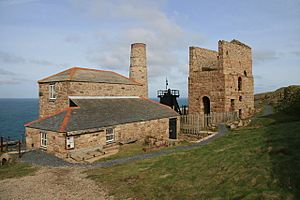Levant Mine and Beam Engine facts for kids
Quick facts for kids Levant Mine and Beam Engine |
|
|---|---|

Boiler house (with chimney) and whim building on the left, pump engine house to the right
|
|
| Type | industrial heritage, mine |
| Location | Trewellard, Cornwall |
| Owner | National Trust |
| Type | Cultural |
| Criteria | ii, iii, iv |
| Designated | 2006 (30th session) |
| Part of | Cornwall and West Devon Mining Landscape |
| Reference no. | 1215 |
| Region | Europe and North America |
|
Listed Building – Grade II
|
|
| Designated | 1979 |
| Reference no. | 1143268 |
| Lua error in Module:Location_map at line 420: attempt to index field 'wikibase' (a nil value). | |
Levant Mine and Beam Engine is a special historical site in Cornwall, England. It's owned by the National Trust. The most amazing thing here is the world's only Cornish beam engine that still works using steam right where it was first built!
You can also visit a special centre and take a short underground tour. The South West Coast Path is nearby, leading to Botallack Mine along the cliffs. In 1919, a tragic accident happened when the engine used to move miners failed. This led to the deaths of thirty-one men. Since 2006, the mine has been part of a UNESCO World Heritage Site, called the Cornwall and West Devon Mining Landscape.
Contents
Location
The Levant Mine was first opened in 1820. It closed in 1930. Miners dug for tin and copper ores here. The mine went very deep, about 600 metres (nearly 2,000 feet).
It was known as the "mine under the sea." This is because its tunnels stretched up to 2.5 kilometres (about 1.5 miles) from the cliffs, right under the ocean! The working beam engine you can see today was built around 1840 by Harvey's of Hayle.
History of the Mine
Levant Mine started in 1820. It was set up with twenty shares, each costing £20. From when it opened until about 1883, the mine made a profit of £171,000. This came from around £1,300,000 worth of ore.
In 1882, new owners took over the mine. They signed a 21-year lease. They also replaced old machines and made improvements to the surface buildings.
By 1883, three main shafts were in use. One shaft had a "man-engine" for miners. Another had a pumping-engine to remove water. The third shaft was for hauling out ore in skips. Two other shafts were no longer used.
There were six large engines at the mine:
- A pumping-engine (with a 45-inch cylinder) to pump water out of the mine.
- A stamping-engine (30-inch cylinder) to break up the ore.
- A winding-engine, or whim (26-inch cylinder), to bring ore to the surface.
- A man-engine (24-inch cylinder) for moving miners.
- A crushing-machine (18-inch cylinder) for further breaking ore.
- Another winding-engine (14-inch cylinder) for raising ore.
The Cornishman newspaper described the working conditions in 1883. About 366 men, boys, and girls worked there. This was fewer than the 600 workers before 1882. Miners worked in three eight-hour shifts, every day except Sunday. Fifty to sixty men worked underground in each shift.
Miners used ladders to get to the lower levels. The temperature underground was very hot, around 33 degrees Celsius (92 degrees Fahrenheit). Miners would sweat a lot. They were given spring water in large containers. Few miners could work underground after age 35.
The tunnels were about 7 feet high and 3-4 feet wide. The valuable ore vein was much smaller, only 6 inches to 3 feet wide. This meant miners had to cut away a lot of hard rock around the ore. Explosives were used to expand the tunnels. Miners would drill a 20-inch deep hole by hand, which took about two hours. Then, gunpowder was placed in the hole. Sometimes, the gunpowder would explode too early, causing many injuries and even deaths. A 14-inch cylinder engine lifted the ore to the surface using skips. These skips ran on two parallel tracks, with one going up as the other went down.
The 1919 Disaster
On October 20, 1919, a terrible accident happened. Thirty-one miners died when a metal part broke on the man engine. The man engine was a special lift for miners. To use it, miners stepped onto a moving platform, were lifted 12 feet up or down, then stepped off onto a small ledge. They waited for the platform to move again, then stepped back on. This process was repeated.
When the metal part broke, the main rod snapped into many pieces. Heavy wooden beams crashed down the shaft. A large rescue effort saved some miners. However, the man engine was never replaced. The lower parts of the mine were then closed off forever.
Minerals Found at Levant Mine
Miners at Levant found several different minerals and ores:
- silver
- bismuth
- calcspar (a type of calcite)
- aragonite
- vitreous copper ore or grey sulphuret of copper (a copper ore)
See also
- Man engine for more about the type of engine involved in the 1919 accident.
- Geevor Tin Mine, another mine close to Levant.
- South Crofty
- Wheal Jane
- Consolidated Mines
- Devon Great Consols
- Botallack Mine
Images for kids







